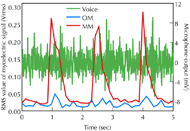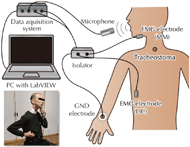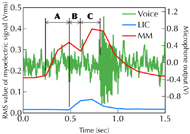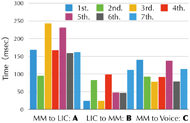~Estimation Of Myoelectric Signal Measurement Point~
Katsutoshi Oe, Kazutaka Hosokawa
Daiichi Institute of Technology (Kirishima)
INTRODUCTION
Laryngectomy is one of the therapeutic methods for laryngeal cancer patients. However, the patients lose their larynxes include their vocal cords after the treatment. As the vocal cords generate the fundamental tone, the patients who lost their vocal cords could not generate their fundamental tone, as the result, they lost their voice. Some substitutional speech methods are proposed and used for these patients. The esophageal speech method is one of these speech methods, and the mucosa of upper trachea is vibrated by the air captured in trachea and it is used as the fundamental tone generator in this method. T this method is very convenient because of no required devices, and its voice quality is close to normal human voice. Many patients try to master this speech method, but the patients who could be reached the daily conversation level are about only 60%. Furthermore, it is said that they need about 6 months to master it. [1] It is considered that this fact is caused on that there are no systematic training methods for the esophageal speech method. One of the difficult points of this speech method is “How to insert the air into the trachea”.
Therefore, we aimed to develop the training device for efficient training of esophageal speech method. For realization of this device, we analyze the body action at esophageal speech, and visualize the muscle activity from the analytical result. The visualized result is applied to the training device, and present to the device user as the indicator of the body action. In this report, the result of muscle activity verification in esophageal speech by the myoelectric signal is described.
SURVEY OF ESOPHAGEAL SPEECH USERS

It is important that the identification of what muscle is activated when the esophageal speech method is used. Therefore, we surveyed the where place of the body was strained while the esophageal speech by questionnaire to esophageal speech users. Additionally, the query “How many syllables can you generate in one phonation?” were asked. The respondents are 11 esophageal speech users, 50s to 80s years old.
The result of the questionnaire is shown in Figure 1. The “abdominal region” is the most popular answer, and the “mouth” and the “shoulder” are followed. This trend is seen both the skilled person who can generate more than 10 syllables in one phonation and the non-skilled person. From this result, it is estimated that the patients insert the air into the trachea by an abdominal breathing and a tongue while the esophageal speech. Therefore, to clarify the activation sequence of the muscle while the esophageal speech, we measure the myoelectric signal of these region.
DETERMINATION OF MEASUREING MUSCLE
Measuring muscle

In the abdominal breathing, the thorax is expanded by descending and shrinking of the diaphragm while inspiration phase, and shrinking by relaxing and ascending of the diaphragm while exhalation phase. Therefore, the diaphragm was chosen as the measuring muscle of myoelectric signal for abdominal region. From some references, the xiphisternum located on the lower end of the breast bone (hereinafter, called “LEB”) [2] and the lowest intercostal on middle line of right clavicle (hereafter, called “LIC”) [3] were became as candidates for the measurement point. These two points are shown in figure 2.
The RMS value of these myoelectric signal were calculated, and the muscles suitable for measurement of diaphragm and tongue movement were decided.
Method
The measurement procedure is shown as follows.
- The test subject uttered “a”.
- The voice and myoelectric signals were measured at the same time.
- The measurement points were 1) LEB and LIC for diaphragm, and 2) OM and MM for tongue.
- These signals were evaluated by microphone output for voice, and RMS value for myoelectric signal.
The test subject was a 60s male who used esophageal speech method on a daily basis with 20 years. The myoelectric signal was measured by SX230 (Biometrcs Ltd.), the voice was measured by MI-1223 (Ono Sokki Co.Ltd.), and the measured signals were acquired and processed by PC equipped the LabVIEW 2012 (National Instruments Co.).
Results and discussions

Figure 4 shows the time-series plot of the RMS value of myoelectric signals and the microphone output in the diaphragm motion and figure 5 shows the same plot in the tongue motion.

From figure 4, it is clarified that the RMS value of LIC is larger than that of LEB, and from figure 5, the RMS value of MM is larger than OM. Therefore, the LIC and the MM were chosen as the target muscles for myoelectric measurement.
TIME-SERIES MEASURMENT OF MYOELECTRIC SIGNAL AND VOICE
Purpose
For clarification of the activation order and the activation timing of the muscles, the myoelectric signals of the MM and the LIC, and the voice were measured at the same time.
Method
The schematic diagram of the measurement system is shown in figure 6. The measurement procedure is shown as follows.

- The measurement electrodes were attached to the skin surface above the LIC and the MM.
- A GND electrode was attached to wrist.
- Test subject uttered “a”, 7 times.
- Both myoelectric signals and the microphone output were measured at same time.
The test subject is same as the above- mentioned measurement.
Results and discussions
Figures 7 shows an example of the time- domain measurement of the myoelectric signals of the MM and the LIC, and the output voltage of microphone.

From this figure, the time differences shown in the following were estimated.
A: the 1st rising of myoelectric signal for MM and the rising of myoelectric signal for LIC. B: the rising of myoelectric signal for LIC and the 2nd rising of myoelectric signal for MM. C: the 2nd rising of myoelectric signal for MM and the rising of voice.
The time differences about other 6 trials were estimated in the same method, too. Each time differences of 7 trials are shown in figure 8. Additionally, the averaged time and the standard deviation of 7 trials are shown in table 1.
Tongue to diaphragm: A
|
Diaphragm to tongue: B
|
Tongue to voice: C
|
|
|---|---|---|---|
Averaged time (msec)
|
207.5
|
103.8
|
203.9
|
Standard deviation
|
59.1
|
45.8
|
45.5
|
From this result, it was clarified that the muscle activation order was 1) MM, 2) LIC, 3) MM, and the voice started after that. This activation order was same as all 7 trials, this means that this esophageal speech user uses his muscles of tongue and diaphragm in same sequence every time. However, the time differences of each trial were dispersion, and their standard deviations were large. To realize the esophageal speech method training device, it is valid that the muscle activation sequence is same. But the standard deviation of time difference is large, it seems difficult to indicate of muscle activation timing to device users at this stage.
CONCLUSIONS

In this report, we proposed the esophageal speech training device with myoelectric signal. And the muscles activation order was measured by myoelectric signal. From the results, the follows have been concluded.
- The tongue and the diaphragm were activated while the esophageal speech.
- The lowest intercostal on middle line of right clavicle and the mylohyoid muscle were selected as the measurement points.
- The order of muscles activation was 1) mylohyoid muscle, 2) the lowest intercostal on middle line of light clavicle and 3) mylohyoid muscle, after that the phonation was started.
In the future, we will measure the time difference data by using of more test subjects to get the more accurate timing of muscle activation.
REFERENCES
- [1] Kumakura I, et al. Hassei Gengo Shogaigaku 2nd ed. Tokyo: Igaku Shoin; 2015 (Japanese)
- [2] Morishita S, et al. Constructing a system of the quantitative measurement of the human laughter by elect romyography (EMG) and an applied study for human health. Research report of Grants-in-Aid for Scientific Research 2014 (Japanese)
- [3] Kaneko H, et al. Changes in respiratory muscle activity during repeated measurements of maximal inspiratory pressure. Regakuryoho Kagaku 2010 25(4):487-492 (Japanese)
- [4] Okitsu T, et al. The surface electromyography on suprahyoid muscles during swallowing. Japan Journal of Rehabilitation Medical 1998 35(4):241-244 (Japanese)
ACKNOWLEDGEMENTS
Special thanks to Mr. Inoue and the members of “Kagoshima Kakureikai”, who cooperated in the measurement and survey.
A part of this research is supported by JSPS KAKENHI grant number 17K01602.
